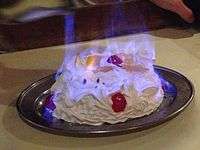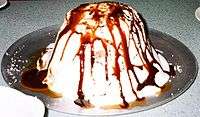Baked Alaska
 A baked Alaska | |
| Alternative names | Glace au four, omelette à la norvégienne (Norwegian omelette), omelette surprise |
|---|---|
| Course | Dessert |
| Place of origin | France or United States |
| Region or state | Paris or New York City |
| Main ingredients | Ice cream, sponge cake or Christmas pudding, and meringue |
| Variations | Bombe Alaska, flame on the iceberg |
|
| |
Baked Alaska is a dessert food consisting of ice cream and cake topped with browned meringue.
Etymology
The most common claim about the name "baked Alaska" is that it was coined at Delmonico's, a restaurant in New York City, New York, USA, by its chef de cuisine Charles Ranhofer in 1867 to honor the acquisition by the United States of Alaska from the Russian Empire on March 30 that year.[1] However, no contemporary account exists of this fact, and the name would not be used until some years after the Alaska Purchase. Ranhofer himself called the dish an "Alaska, Florida" in 1894, apparently referring to the contrast between its cold and hot elements.[2] The dish is also known as an "omelette à la norvégienne" or "Norwegian omelette", which similarly refers to the cold climate of Norway.[3]
Other names for the dish are glace au four and omelette surprise. A similar dessert in Hong Kong is known as flame on the iceberg.
Preparation
.jpg)
The dish is made of ice cream placed in a pie dish lined with slices of sponge cake or Christmas pudding and topped with meringue. The entire dessert is then placed in an extremely hot oven for a brief time, long enough to firm and caramelize the meringue.[1] The meringue is an effective thermal insulator, and the short cooking time prevents the heat from getting through to the ice cream and melting it.
The process for making baked Alaska was simplified in 1974 by Jacqueline Halliday Diaz, who invented a baking pan that forms a fillable hollow in the cake that may be filled with ice cream.
Variations
In 1969, the recently invented microwave oven enabled Hungarian physicist and molecular gastronomist Nicholas Kurti to produce a reverse baked Alaska (also called a "Frozen Florida")—a frozen shell of meringue filled with hot liquor.[4]
A variation called bombe Alaska calls for some dark rum to be splashed over the baked Alaska. The lights are then turned down and the whole dessert is flambéed while being served.[5]
Flame on the iceberg is a popular dessert in Hong Kong that is similar to baked Alaska. The dessert is an ice-cream ball in the middle of a sponge cake, with cream on the top. Whisky and syrup are poured over the top and the ball set alight before serving.[6] Decades ago, the delicacy was served only in high-end hotels, but today it is commonly served in many Western restaurants and even in some cha chaan teng.
-

A bombe Alaska at a restaurant in Singapore which has been flambéed with alcohol
Cultural significance
February 1 is supposedly Baked Alaska Day in the United States.[7]
See also
- Bananas Foster
- Bombe glacée – similar to a baked Alaska, but typically using chocolate coating instead of meringue for the outer layer
- Fried ice cream
- List of desserts
Notes
- 1 2 "Baked Alaska". Foodreference.com. Archived from the original on 17 June 2016. Retrieved 27 August 2016.
- ↑ Charles Ranhofer (1894). "(3538). ALASKA, FLORIDA (Alaska, Florida)". The Epicurean. A Complete Treatise of Analytical and Practical Studies of the Culinary Art including Table and Wine Service, how to Prepare and Cook Dishes, and Index for Marketing, A Great Variety of Bills of Fare for Breakfasts, Luncheons, Dinners, Suppers, Ambigus, Buffets, etc., and a Selection of Interesting Bills of Fare of Delmonico's from 1862 to 1894. Making a Franco-American Culinary Encyclopedia. [...] Illustrated with 800 Plates (1st ed.). New York, N.Y.: Charles Ranhofer, publisher, 682 West End Avenue. p. 1007. OCLC 944768.
- ↑ John Ayto (1990). The Glutton's Glossary: A Dictionary of Food and Drink Terms. London; New York, N.Y.: Routledge. p. 14. ISBN 978-0-415-02647-5.
- ↑ Martin Lersch. "Molecular gastronomy: History". Khymos. Archived from the original on 1 May 2016. Retrieved 1 May 2016.
- ↑ Geoff Jansz. "Bombe Alaska". Burke's Backyard. Archived from the original on 6 March 2016. Retrieved 6 March 2016.
- ↑ "Gorilaz" (23 June 2009). "另类雪糕 冰山大火/火焰雪山". Flyker.cn (in Chinese). Archived from the original on 4 March 2016. Retrieved 4 March 2016.
- ↑ "American Holidays". State Symbols USA. Archived from the original on 24 March 2016. Retrieved 24 March 2016.
References
- Ayto, John (2002). "Baked Alaska". An A–Z of Food and Drink (new ed.). Oxford: Oxford University Press.
- Olver, Lynne (8 February 2015). "Baked Alaska". The Food Timeline. Archived from the original on 19 August 2016.
External links
-
 The dictionary definition of baked alaska at Wiktionary
The dictionary definition of baked alaska at Wiktionary
